Are you a hunter who wants to know how to locate deer? Don’t you worry! Knowing about the habitat of deer can be an easy way to navigate them and we’ll guide you into this.
These highly adaptive animals can survive from cold Arctic Tundra to the lush canopies of tropical forests. But do you know that they follow a pattern for their habitat? It requires 3 key components!
They are – “Food, security and water”. Other than that, for their habitats, they’re very picky. Thus, in order to understand the habitat of deer you need to understand its behavior too.
We’ll unveil deeply about deer habitats. Let’s check it out-
What are the Habitat Diversities and Distribution of Deer?
Deer are graceful animals with gorgeous antlers that thrive in a variety of locations around the world. These animals have established themselves in a variety of settings, ranging from the freezing tundras of the Arctic to the hot forests of Africa.
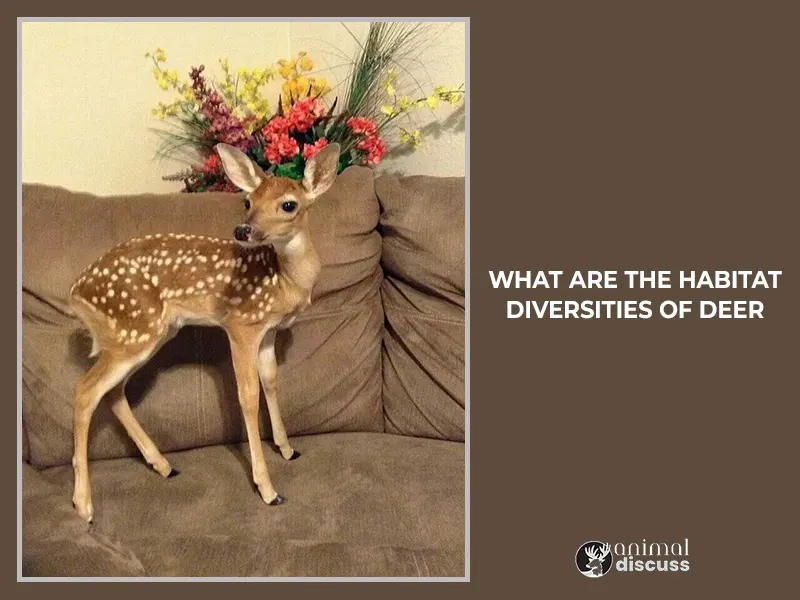
Well, their distribution underscores their ecological versatility and adaptability too. Let’s have a look at the many types of habitats they prefer.
Geographical Range and Environmental Adaptability
Global Presence: They live in most of the continents, like North America, Europe, Asia, and some countries in South America. The fact that they are found in many places shows that they can easily live in a variety of environmental conditions.
Climatic Tolerance: Deer can live in a wide range of temperatures. Such as there are arctic tundras where reindeer live, as well as temperate forests and tropical jungles where white-tailed and red deer live.
Habitat Types and Preferences
Forest Habitats: The White-tailed Deer and European Roe Deer are two types of deer that thrive in forested areas. These areas provide cover and a variety of food sources like leaves, fruits, nuts, and mushrooms for the deer.
Deer are protected from predators by heavy greenery, and decaying wood and rock formations provide nice sleeping spots for them.
Grasslands and Prairies: Grasslands are also chosen by some species of deer as their habitat. Grasslands have easy access to foods like grasses, herbs, fruits, etc.
Moreover, as grasslands are open spaces, it allows the deer to detect the predator very easily. Thus, they can save themselves from it.
Tundras: You’ll be amazed to hear that the deer not only lives in greenery areas but also in the tundras. Tundra is basically a frigid and barren region characterized by permafrost soil. It has a limited capacity to maintain plant life.
However, in tundra, deer can consume lichens, mosses, and low-lying plants. And for the shelter, they choose structures of rock that equally protect them from wind and predatory animals.
Deserts: Though deserts are barren and dry regions that lack sufficient food and water but still mules, addax deer, etc. live here.
Likewise, certain species of deer can survive by consuming cactus plants, succulents, and desert bushes. Caves and streams composed of rocky terrain provide shelter from the scorching sun and hazardous wildlife.
Mountainous Regions: Surprisingly deer live in mountain regions too! For instance, Rocky Mountain Elk as well as Himalayan musk deer are some of those species that can adapt to harsh, rocky environments.
Regional Variations
North America: Beginning with, white-tailed deer inhabit the woodlands in the eastern region, while mule deer inhabit the rocky highlands and the Great Basin. On the other hand, Black-tailed deer reign over the dense forests near the Pacific coast.
These renowned species survive in their respective regions due to variations in vegetation, temperature, and predator pressure.
Europe: When it comes to Europe, two common species are noticed here such as red deer and roe deer. In forested habitats ranging from the Mediterranean to the Boreal forests they inhabit.
Asia: Asia contains a wide range of habitats for deer, from tropical jungles to the Siberian taiga, which is home to reindeer. They are found in Southeast Asia and feed on animals such as sambar deer.
South America: The South Andean deer species inhabits the Andes mountain range and certain regions of the Southern Cone. They are capable of inhabiting mountainous regions.
Seasonal Migration: Elk migrates upwards into higher elevations during summer and lowlands in valleys for winter feeding as well as evading heavy snow.
What Makes a Place a “Good” Habitat of Deer?
We’ve already talked a bit about the key components that are essential for a deer to choose their habitat. Now we’ll be discussing them in a broad way to understand how this ensures their survival and prosperity across diverse landscapes-
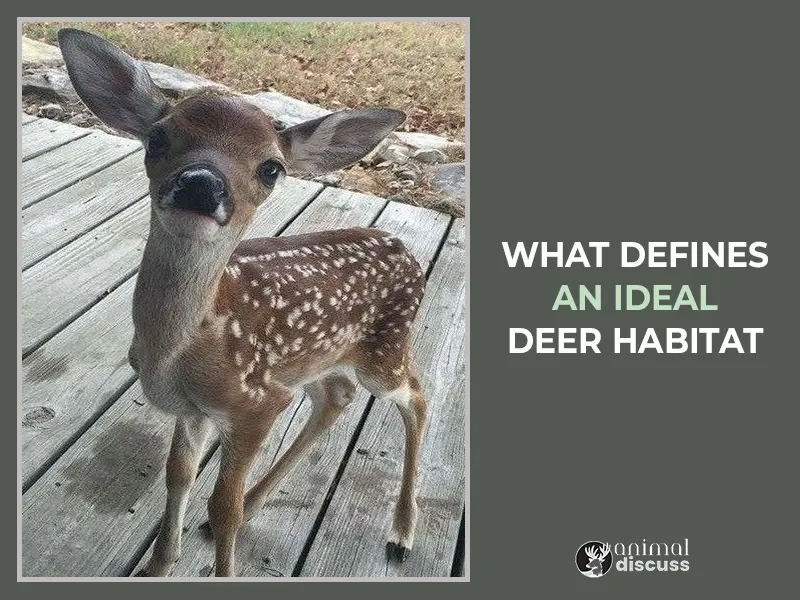
Food Resources
Beginning with the food resources, which is one of the key components for deer to choose their habitat. But what does a deer eat?
Well, mainly deer eat many types of plants including grasses, leaves, twigs, bark, fruits, and crops cultivated by humans. As they are herbivorous animals.
However, their food patterns change depending on the season. In spring and summer, they consume mostly new growth and more herbaceous plants. Whereas, in fall and winter they depend on more woody plants, nuts, etc.
If you’re eager to know more about their eating habits and expand your knowledge, have a look at our article named “What do deer’s eat?”
Cover for Protection from Predators
Moving to the second key component which is looking for shelter which gives enough coverage and security from predators.
Other than the food resources, they look for places that have dense vegetation, thick underbrush and more wood. So that if any predators come or they have to hide in harsh weather they can go there.
Besides, they look for protected areas because of their fawn too. So, when the doe or male deer is not present a secured and hidden area can keep it safe.
Water Availability
Just like food, water is equally important. And it’s the third key component for deer in choosing their habitat. For hydration, they look for places that are close to river bodies, streams, ponds and even lakes for their regular supply of water.
Shelter and Thermal Cover
Deer are highly adaptive, it’s true! But they need to keep themselves protected from extreme weather too. Therefore, deer look for a habitat that can protect them from heat, cold and rain.
Where Does Deer Live And Sleep?
Till now we’ve talked about deer living and moving during the day but have you ever thought about where a deer sleeps? Though deer are very active even while they are sleeping, choosing the right kind of environment is important too.
Just like we’ve mentioned, deer love to take short naps called cat naps while sleeping. It keeps them alert and cautious even while they’re sleeping or resting.
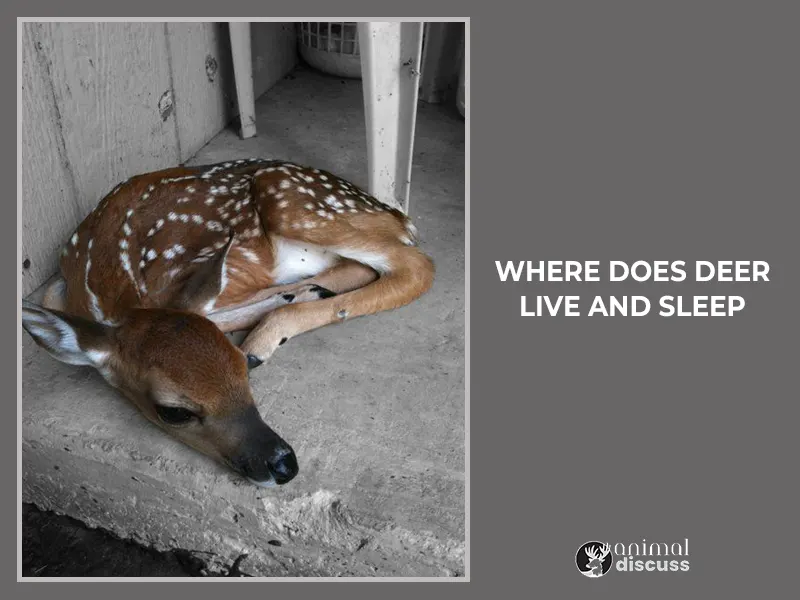
However, deer are very picky when they choose their bedding sites during winter.
It has to be south-facing slopes and has to be a place where there is warmness of sun so that they can rest properly.
You might already know that deer live in groups right? They sleep at different times which helps them to keep an eye on the predators while the other one is sleeping.
How Does the Habitat of Deer Influence What it Eats?
Well, we’ve said multiple times that a habitat is chosen based on food availability and other resources. So for a deer, it’s critical to reside where they can get consistent nutritious food.
You know that deer are herbivores. And they consider forests as their home where they can consume an ample amount of plants. But they don’t eat every type or component of the plant and they shouldn’t do it too.
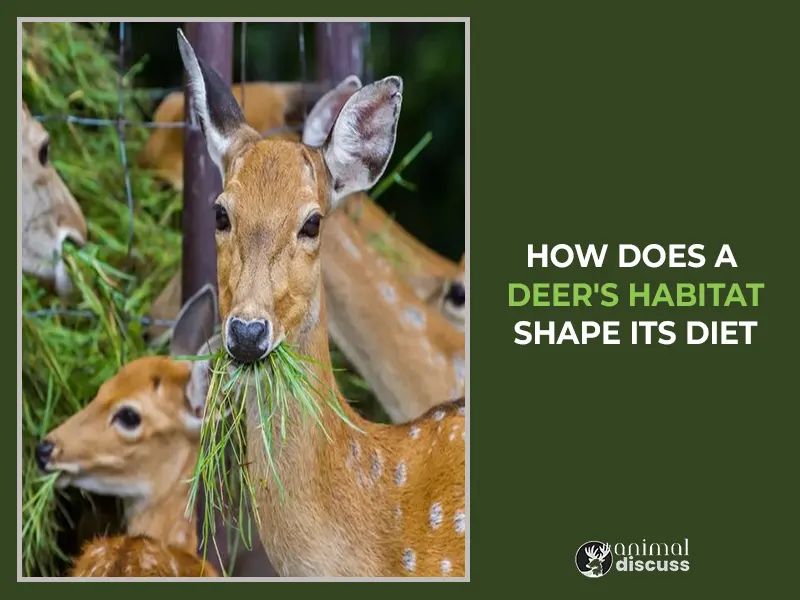
Plants that are beneficial for them and are nutritious for them consume that only. Moreover, they can detect if the plant or the food they have is healthy for them or not.
Deer are intelligent enough to understand that their nutritional requirements fluctuate with the seasons and when they are in their regular reproductive cycle.
That’s why a deer’s habitat influences what it eats. Choosing their habitat accordingly only will fulfill their ample source of nutritious food.
What Are Some Habitat Challenges Deer Face?
For now, we’ve been telling you that deer are very adaptive. But they do face numerous challenges in their habitat, from both natural and human-induced factors
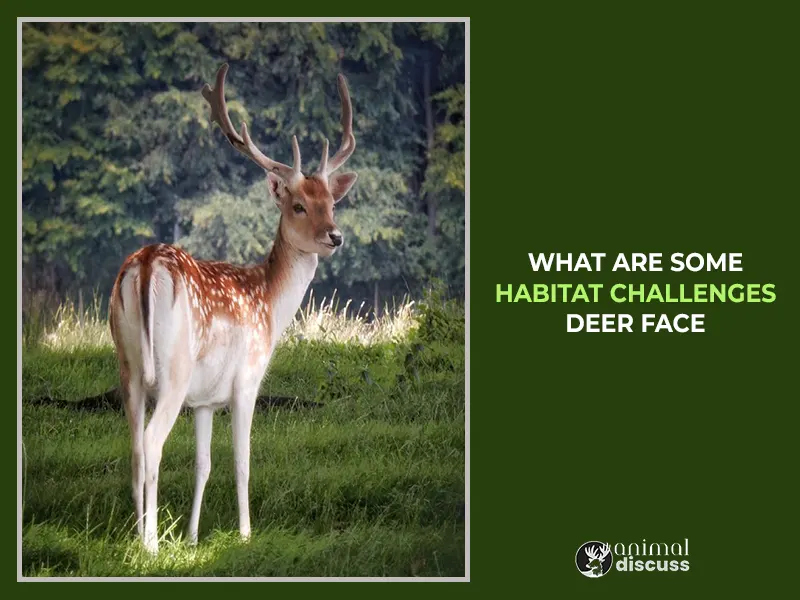
Let’s have a look into the challenges deer face –
Environmental and Climatic Challenges
Deer mostly live in forests or grasslands etc. All of these places have less protection from natural calamities or severe weather conditions.
For instance, if there is heavy snowfall, extreme cold, or prolonged droughts, it can significantly impact deer habitats. That’s because these conditions alter food availability and the accessibility of shelter.
These changes in seasonal patterns other than impacting their eating sources also impact their breeding, and foraging and compel them to migrate.
Moreover, natural disasters like wildfires, floods, and storms can devastate their habitats. As a result, deer had to immediately migrate and adapt to new areas or altered landscapes.
Human-Induced Challenges
It is quite evident that humans are the biggest threat to wildlife creatures. Because of their deforestation, urbanization, vehicle usage, etc., deer had to face different challenges.
In forest areas now there is urbanization, and different infrastructure developments are seen which equally disrupts deer movement. As a result, their availability of space has decreased.
The number of deforestation has increased too. So the removal of forests for timber or to clear land for agriculture eliminates critical cover and foraging areas for deer.
Accordingly, whenever off-road vehicles pass by deer cannot detect the speed. And the number of deer dying has rapidly increased due to it.
Predation and Competition
Staying safe from predators is one of the challenges deer have to keep in mind. Because in some areas the number of wolves or coyotes is more which is risky for deer, especially the fawns. So they’ve to be very careful about it while choosing a habitat.
Other than remaining safe from predators they need to compete with other herbivores like elk or livestock for their food resources. So when their habitat is degraded it gets intensified.
What are the Adaptive Strategies of Deer to Face Habitat Challenges?
Over millennia, they have acquired the knowledge of adapting their behavior to various situations. This enables them to endure and thrive despite the presence of predators and challenging conditions.
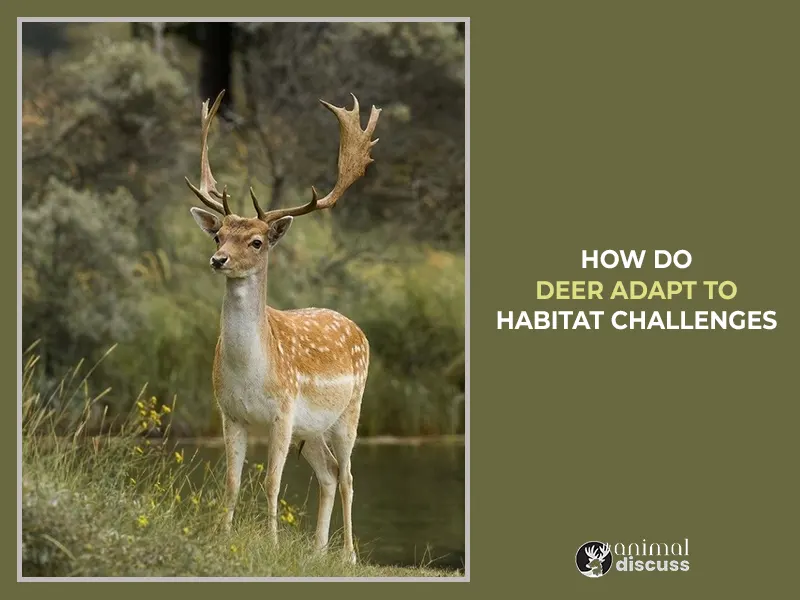
Let’s dive in to learn more –
Behavioral Adaptation
Starting with their behavioral adaptation, it is noticed that several species of deer undergo fur color adaptation to effectively camouflage themselves. This reduces their visibility to potential predators.
Even the spots on young deer help them hide in patches of light and shade in the forest. And the deer movement which is done through toes, making it completely silent, is another behavioral adaptation.
Genetic Adaptability
Over time, deer have evolved physiological and morphological traits that enable them to cope with different environmental stressors.
For instance, deer who are desert dwellers like mules, have the capacity to store an efficient amount of water in their kidneys. Moreover, the arctic survivors grow thick fur to survive icy temperatures.
Deer who are mountain climbers have strong muscular legs and sharp hooves so that they can easily climb. These agile body movements have come after they faced different hardships.
Frequently Asked Questions
Now, let’s look at some additional questions and their answers related to deer’s habitat and conservation stage.
1. What are the usual causes that frequently damage deer habitat?
The habitat of deer is frequently threatened by factors such as climate change, deforestation for agricultural purposes, and similar causes. Predators pose a significant threat to the deer’s habitat too.
2. What measures may be implemented to manage and safeguard the habitat of deer?
Strategically designing construction projects to minimize disruption to existing habitats and establish pathways for wildlife movement.
Moreover, spreading knowledge, increasing research and law enforcement regarding the significance of providing a secure habitat for deer could work well in that sense.
3. What is the communication method used by deer while hiding?
Deer communicate with one another through sounds, body movements, and scent recognition. Deer employ various methods of communication to engage in mating, convey warning signals, and establish supremacy.
Conclusion
When it comes to habitat deer are a very picky animal! We’ve noticed deer living in various habitats, ranging from lush tropical forests to freezing arctic tundras.
However, these animals face several challenges, including harsh weather, fragmented habitats, changes brought about by humans, and predation.
After knowing the challenges they face in their everyday life, what we can do is educate people about them. We hope this article on the habitat of deer has answered your queries.
References
- https://www.pgc.pa.gov/Wildlife/WildlifeSpecies/White-tailedDeer/Pages/Deer-HabitatRelationships.aspx
- https://deerassociation.com/deer-habitat-in-a-squirt-bottle-part-1-add-great-deer-habitat-by-subtracting/
- https://www.naturalresources.msstate.edu/manage-your-land/game/deer.php
- https://deer.wildlifeillinois.org/deer-ecology/landscapes-and-deer/

